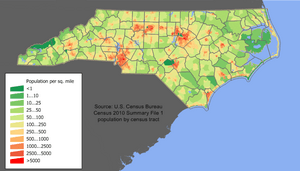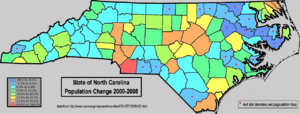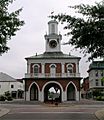Demographics of North Carolina facts for kids
North Carolina is a state in the United States with a rich mix of people from many different backgrounds. Studying the Demographics of North Carolina helps us understand who lives here and how the population has changed over time.
| Historical population | |||
|---|---|---|---|
| Census | Pop. | %± | |
| 1790 | 393,751 | — | |
| 1800 | 478,103 | 21.4% | |
| 1810 | 556,526 | 16.4% | |
| 1820 | 638,829 | 14.8% | |
| 1830 | 737,987 | 15.5% | |
| 1840 | 753,419 | 2.1% | |
| 1850 | 869,039 | 15.3% | |
| 1860 | 992,622 | 14.2% | |
| 1870 | 1,071,361 | 7.9% | |
| 1880 | 1,399,750 | 30.7% | |
| 1890 | 1,617,949 | 15.6% | |
| 1900 | 1,893,810 | 17.1% | |
| 1910 | 2,206,287 | 16.5% | |
| 1920 | 2,559,123 | 16.0% | |
| 1930 | 3,170,276 | 23.9% | |
| 1940 | 3,571,623 | 12.7% | |
| 1950 | 4,061,929 | 13.7% | |
| 1960 | 4,556,155 | 12.2% | |
| 1970 | 5,082,059 | 11.5% | |
| 1980 | 5,881,766 | 15.7% | |
| 1990 | 6,628,637 | 12.7% | |
| 2000 | 8,049,313 | 21.4% | |
| 2010 | 9,535,483 | 18.5% | |
| 2020 | 10,439,666 | 9.5% | |
| Source: 1910–2020 | |||
Contents
North Carolina's Growing Population
North Carolina has been growing very quickly! In 2009, the state's population was about 9.4 million people. This was a big jump of about 1.3 million people since the year 2000. This growth is faster than the rest of the United States.
Many new people have moved to North Carolina from other states and countries. This has helped the state grow a lot. Between 2005 and 2006, North Carolina became the 10th most populated state in the country. About 6.7% of the people are under 5 years old, 24.4% are under 18, and 12.0% are 65 or older. About 51% of the population are females.
Where People Live: Big Cities and Areas
Most people in North Carolina live in or around big cities. The state has three main "Combined Statistical Areas" with over 1 million people each:
- Charlotte Metro: This area includes Charlotte, Concord, and Gastonia. It has about 2.4 million people.
- The Triangle: This area includes Raleigh, Durham, and Cary. It has about 2.1 million people.
- Piedad Triad: This area includes Greensboro, Winston-Salem, and High Point. It has about 1.5 million people.
North Carolina also has many large cities. Here are some of the biggest cities with over 100,000 people (based on 2010 numbers):
- Charlotte: About 731,424 people.
- Raleigh: About 403,892 people.
- Greensboro: About 269,666 people.
- Winston-Salem: About 229,617 people.
- Durham: About 228,330 people.
- Fayetteville: About 200,564 people.
- Cary: About 135,234 people.
- High Point: About 104,371 people.
- Wilmington: About 106,456 people.
Different Groups of People
North Carolina is home to many different ethnic and racial groups. In 2015, about 71.2% of the people were White, 22.1% were African American, 1.6% were American Indian, and 2.8% were Asian. Also, 9.1% of the population was Hispanic or Latino (who can be of any race).
North Carolina used to be mostly rural, meaning most people lived on farms or in small towns. But now, more and more people are moving to cities and suburbs. Cities like Charlotte and Raleigh have grown a lot. They are now big, diverse places with many different cultures. This diversity has grown because many people have moved here from Latin America, India, and Southeast Asia.
Many people from other parts of the U.S., like the Northeast, Florida, and California, have also moved to North Carolina. This makes the state a mix of many different backgrounds.
African American Population
African Americans make up almost a quarter of North Carolina's population. More middle-class African Americans have emerged since the 1970s. Many African Americans live in the eastern part of the state and in the central "Piedmont Crescent" area. This is where they have historically lived and where new jobs have appeared.
Hundreds of African American communities are found in rural counties in the south-central and northeast parts of North Carolina. There are also many African American neighborhoods in cities like Charlotte, Raleigh, Durham, and Fayetteville.
Asian American Population
North Carolina has a fast-growing number of Asian Americans. Many people from India and Vietnam have moved here. Their numbers have grown a lot since 1990 as they came for new jobs.
North Carolina is home to the largest group of Montagnards in the U.S., with about 10,000 people. These refugees came from the Central Highlands of Vietnam. Many live in Charlotte, Raleigh, and especially Greensboro.
Also, many Hmong people came to North Carolina in the 1980s. They were refugees from wars in Laos. Now, about 12,000 Hmong live in the state.
The first Chinese immigrants came to North Carolina in the mid-1800s to work in mines and on farms. The famous Thai "Siamese" twins, Eng and Chang Bunker, settled in Mt Airy in 1839. Smaller groups of Japanese, Filipinos, and Koreans also came to work in farming and fishing.
European American Population
The first European settlers in North Carolina were mostly English immigrants. Many came from Virginia or as indentured servants. Other European groups also settled here, including Irish, French Huguenots, and Swiss Germans. A group of Welsh people settled near Fayetteville in the 1700s.
People of Scots-Irish, Scottish, and English backgrounds live all over the state. Historically, the Scots-Irish and Northern English settled more in the central and western parts of the state. They were independent farmers.
In the Winston-Salem area, many people have German ancestry. They are descendants of the Protestant Moravian Church members who came in the mid-1700s. North Carolina is also home to over 10,000 Bosnian Americans. Greeks have been here since the early 1900s, with seven Greek Orthodox churches. A small group of Ukrainian immigrants settled in Pender County in the early 1900s.
There is a long history of Portuguese settlement along the coast. Their families were fishermen from the Azores islands. Over 50,000 people in North Carolina have Portuguese roots. Basque fishermen from Spain and France also visited the coast. Many Canadians (both English and French-speaking) also live in coastal towns during the winter.
Latino American Population
Since 1990, the number of Hispanics and Latinos in North Carolina has grown a lot. Many came for jobs that were the first step on the economic ladder. Most are from Mexico, but also from Puerto Rico and other Central American or Caribbean countries. Many Hispanics are also moving to North Carolina from other U.S. states. In some neighborhoods, like Eastland in Charlotte, Mexican Americans are the main group. New neighborhoods with Latin American culture are growing in the Raleigh area.
Native American Population
North Carolina has the largest American Indian population on the East Coast. In 2004, there were about 110,198 Native Americans in the state. North Carolina officially recognizes eight Native American tribes:
- The Eastern Band of Cherokee Indians live in western North Carolina. They have about 13,400 members, mostly on their reservation called the Qualla Boundary.
- The Lumbee Tribe of North Carolina is the largest tribe in the state, with over 55,000 members. They live mainly in southeastern North Carolina.
- The Haliwa-Saponi Indian Tribe has about 3,800 members in northeastern North Carolina.
- The Waccamaw-Siouan Tribe has almost 2,000 members in mid-Atlantic North Carolina.
- The Coharie Intra-tribal Council, Inc. has 1,781 members in Sampson and Harnett counties.
- The Sappony tribe has 850 members.
- The Occaneechi Band of the Saponi Nation has 800 members in Orange and Alamance counties.
- The Meherrin Nation has 557 members in northeastern North Carolina.
Only five other states in the U.S. have more Native American people than North Carolina.
Languages Spoken
In 2010, most people in North Carolina (about 89.66%) spoke English at home. However, many other languages are also spoken! About 6.93% of people spoke Spanish. Other languages spoken by many people include French, German, and Chinese. In total, over 10% of North Carolina's population speaks a language other than English at home.
| Language | Percentage of population (as of 2010) |
|---|---|
| Spanish | 6.93% |
| French | 0.32% |
| German | 0.27% |
| Chinese (including Mandarin) | 0.27% |
| Vietnamese | 0.24% |
| Arabic | 0.17% |
| Korean | 0.16% |
| Tagalog | 0.13% |
| Hindi | 0.12% |
| Gujarati | 0.11% |
| Russian | 0.11% |
| Hmong | 0.11% |
| Italian | 0.08% |
| Japanese | 0.08% |
Religions
North Carolina, like other Southern states, has traditionally had a large Protestant population. For a long time, Southern Baptists were the largest Protestant group.
However, with many new people moving in, the number of Roman Catholics and Jewish people is growing. This is especially true in big cities like Charlotte and Raleigh-Durham. Even with these changes, Southern Baptists are still the largest Christian church in the state.
Methodists are the second-largest Protestant group. They are strong in the northern Piedmont area, especially in Guilford County. There are also many Quakers in Guilford County and northeastern North Carolina.
Presbyterians, who often have Scots-Irish roots, have a strong presence in Charlotte and Scotland County.
Jews started arriving in North Carolina in the early to mid-1800s. These early merchants, often German Jews, set up communities in coastal cities like Wilmington. Later, more Eastern European Jews came to cities like Charlotte and Greensboro. Today, most Jewish communities are in the larger Piedmont cities. Recently, more Jewish people have moved to Western North Carolina, in places like Asheville. It's estimated that about 30,000 Jewish people live in North Carolina.
Here's a look at religious groups in North Carolina as of 2001:
- Christian: 79%
- Protestant: 57%
- Baptist: 38%
- Methodist: 9%
- Presbyterian: 3%
- Lutheran: 2%
- Other Protestant: 5%
- Roman Catholic: 10%
- Other Christian groups (like non-denominational, Pentecostal, Mormon): 12%
- Protestant: 57%
- Judaism: 1%
- Muslim: 1%
- Other religions: 3%
- Non-religious: 10%
- Refused to answer: 7%
Images for kids

















